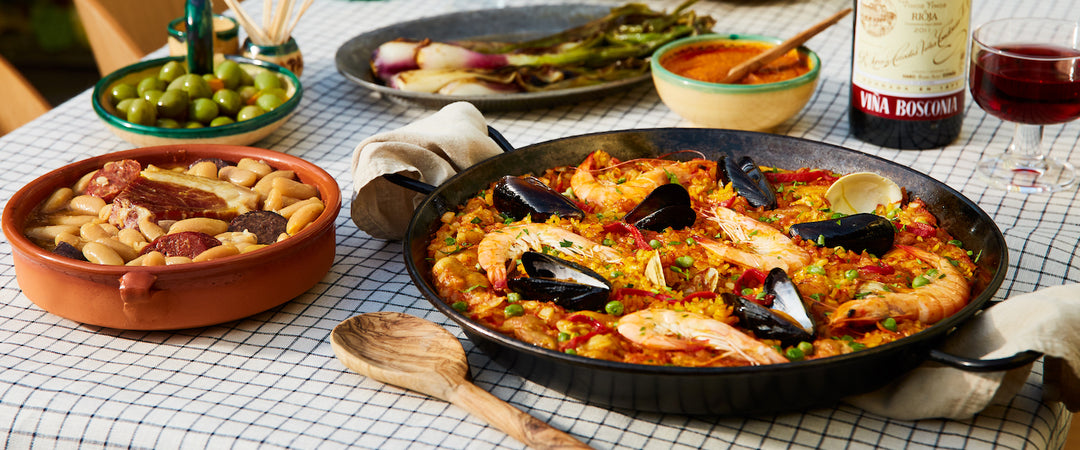December 2024 Blanco y Branco Club
 
|
Ossian Verdejo, Segovia
Availailable on request
|
For the December Blanco Y Branco club we took a beauty and the beast pairing approach, pairing a $55 old-vine barrel aged 94 point scoring Verdejo (the beast) from Spain with a fresh, spritely, youthful $17 Portuguese beauty, the Arca Nova Alvarinho (the beauty).
As we have written previously in an email we send out once a year on Verdejo day, Verdejo is one of the greatly underappreciated grapes of Spain. It’s the wine of choice for many a simple and delicious “blanco” you will drink while in Spain, and most Verdejo are fresh, inexpensive styles. And that’s the Verdejo most people know. Yet there is much more to Verdejo, with old vine, barrel-aged Verdejos coming close to amazing Chablis. The eponymous Belondrade Y Lurton and Nisia Las Suertes come to mind, and after you taste this wine, you will add Ossian to the list.
The majority of Spanish Verdejo is grown within the bounds of the Rueda DO, adjacent to Spain’s famous Ribera Del Duero in the area just south of Valladolid, about 140 miles northwest of Madrid. It is part of the much larger Castilla Y Leon Certification of Origin region. Within this region, Verdejos’ reach extends far and wide, with a staggering variety of vineyards. One unique feature to Rueda are old vineyards in areas with sandy soil. These soils acted as a natural defense against the phylloxera root louse that devastated much of the rest of Europe's vineyards planted on native root stocks in the late 19th century. As a result, while much of the rest of Spain was forced to replant vines onto new rootstock between the late 19th and early 20th century, vines near Segovia are still on 150-200 year old pre-phylloxeric root stock. Old roots translate into great concentration and finesse in the fruit, which translates to bold, flavorful wines. In addition to having sandy soils, Nieva sits at almost 3000 ft. of elevation. The lean challenging soils force the vines to focus their energy on fewer clusters of ripe fruit and the cool nights due to high altitude help the grapevine’s metabolism recover at night, which maintains acid levels in the grapes which creates freshness and balance in the wine.
The majority of Verdejo is fermented and aged in stainless steel and released after short aging. This style of Verdejo is fresh, bright and citrusy. Ossian is made differently. Fermentation takes place in barrels and the wine is left on the lees in those barrel for 12 months. The lees are regularly stirred up (a process called battonage), which causes the yeast cell walls to break down (called autolysis), releasing many compounds from the cell that add body, richness and additional flavor into the wine. The result is a Verdejo that is refined and elegant, with a fine pear and citrus nose and a longer finish and much bigger mouthfeel than the young Verdejos. The barrel wood contributes vanilla and baking spices, further elevating the elegance of this wine.
The Ossian is a 94 Point scoring heavyweight, eliciting the following words from Spanish reviewer Luis Gutierrez: “The eponymous 2020 Ossian was produced with Verdejo grapes from old, organically farmed vines around the village of Nieva (Segovia), a zone where phylloxera didn't reach. They consider 2020 their finest vintage to date, with a big change from 2018 and when they have achieved a much better understanding of their vineyards. It has notes of pit fruit and sweet spices, with good weight on the palate, moderate alcohol (13.5%) and ripeness and good freshness and balance. It's serious and with potential to develop in bottle.”
This wine dazzles the palate with rich golden hues and settled elegance. Deeply nuanced white ripe orchard fruit (think soft ripe pear), with a hint of tropical fruit flavors are supported by a creamy mouthfeel and roasted herbs and vanilla notes. Luxury in a glass, a beast of a wine. With cold and rainy winter upon us, a melted cheese dish like Raclette or Fondue, while not Spanish, would make for a fantastic cross-border food pairing with this wine. Or, if you want to keep it more Spanish, try a modern twist on traditional cod dishes with a creamy cod bake.
 
|
Arca Nova 2023 AlvarinhoRegular Price: $17.99
Club Price: $ 15.29
|
Maybe the brevity of this writeup is a sign of us getting wine writer's fatigue after writing about some 80 other wines this year. Maybe the brevity also arises from the fact that a simple a beautiful wine doesn't need many words. We tried, but couldn't seem to do much better than simply cleaning up what it says on the bottle, obviously translated in a hurry from Portuguese: "Abundant and elegant floral scents pair with pleasant and fresh fragrances of lemon peel and orange tree blossoms. Very rich structure with a full body and soft feel. Good finish."
The beauty in this wine really doesn't need to be overanalyzed. Alvarinho from the Vinho Verde can be just as good as its counterpart Albarino just from north of the Minho river in Spain. Here in the Vinho Verde region, it's a bit more floral and tropical, but still holds the crisp, mineral appeal of the varietal. Don't expect a fluffy typical Vinho Verde with sweetness and effervescence. This is a serious wine!
Enjoy this with seafood dishes (white flaky fish or shellfish) or as an aperitif, maybe with light fare between the holidays and the New Year. Most of all, don't overthink this wine. Simply get another bottle if you can't figure out WHY you like the first one so much. Happy Holidays and New Year. - BMS



